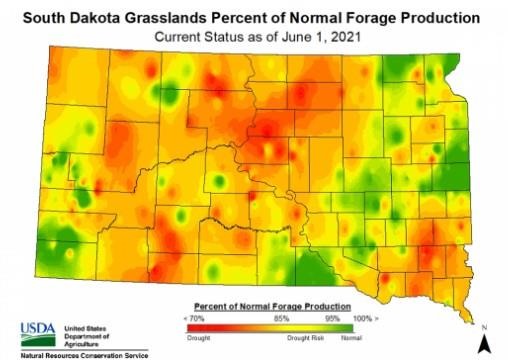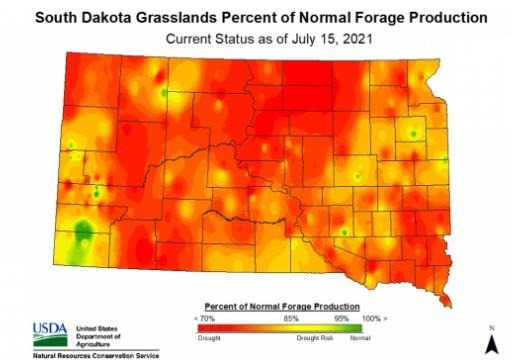By Heather Gessner
Inventorying and planning for hay and other forage feed needs is essential every year, especially when production is uncertain due to drought or excess moisture.
At the beginning of the hay crop year, May 1, 2021, beginning inventory across the nation was down 11.8 percent compared to a year ago and 13.7 percent lower than the five-year average. Five of the top-producing hay states reported stocks were 27.5 to 43.9 percent lower than a year ago and up to 60.3 percent lower than thefive-year average.
Average to higher production, combined with average to higher-than-average temperatures throughout the winter, helped South Dakota stocks. However, South Dakota beginning stocks were 6.4 percent lower than the previous year.Early predictions for the 2021 hay production year indicated a reduction in grass and alfalfa production across the state (Figure 1).

Figure 1. South Dakota grasslands percent of normal forage production. Current status as of June 1, 2021. Courtesy: U.S. Department of Agriculture Natural Resources Conservation Service

Figure 2. South Dakota grasslands percent of normal forage production. Current status as of July 15, 2021. Courtesy: U.S. Department of Agriculture Natural Resources Conservation Service
The Natural Resources Conservation Service (NRCS) estimates in June listed production at 85 percent or less than normal forage production in many counties, with 10–12 counties at less than 70 percent of normal production. Prodcution, as a percent of normal, deteriorated in the July 15 report (Figure 2). With the exception of small pockets, most of the state is classified as drought risk to drought, and a large portion of South Dakota counties are at or near the 70 percent or less of normal forage production.
Anecdotal evidence based on the first cutting of alfalfa harvested in early June, and second cuttings being allowed to mature without being harvested in July, reinforce the reduction in forage production across many areas of the state.
What Can Be Done?
INVENTORY
The first step to feed planning is to take a current inventory of the livestock operation. A list of the number and weight of the animals to be fed is a critical step to determining the needed roughage and other feed needs.
Example: Count the herd and take weights.
- 102 cows, average weight 1325 pounds
- 97 calves, average weight 220 pounds
- Four bulls, average weight 1605 pounds
- Two horses, average weight 1250 pounds
Considering 2.3 percent of body weight required, this herd requires 57 tons of feed per-day before accounting for any waste due to the method of feeding used.
Next, inventory the feed on hand. Count and weigh bales, measure silage piles, measure grain supplies, and do a feed test on these feedstuffs. Counting and weighing ensure an accurate evaluation of the current situation. Feed testing allows for the evaluation of nutrition value available and areas lacking.
NUMBER OF DAYS TO FEED
Given the current dry situation, determining the number of days harvested forages are needed to provide the required nutrition for the herd is more complicated than in traditional grazing years. However, this does not mean “don’t do it.” Create a traditional feed required list, say feeding from November to April, and then evaluate pasture conditions and expected production to determine when animals need supplemented forages and add that to the total required feed number.
PREPARE
“Ignorance is bliss” is a detrimental frame of mind for this situation. Preparation and planning can alleviate shortfalls when identified early.
The Livestock Forage Program (LFP) provides some feed assistance to producers. Talk to your local Farm Service Agency (FSA) office to determine if your county qualifies for assistance and at what level.
Create and evaluate feed options. There is more than one way to feed and take care of livestock, and feed options should be taken into consideration during short feed times.
- Create a sacrifice pasture to feed the herd on. Sacrificing a pasture ensures only one pasture needs to recover from overgrazing when rainfall levels return to normal.
- Drylot the cowherd in your lots or at a custom lot. Determine the economic difference between hauling feed to the cows or hauling the cows to the feed.
- Early wean the calves. Reduce the feed requirements of the cow and reduce the feed production needs from the pasture.
- Invest in hay feeders and bunks. Bale feeders and bunks can improve the utilization of available harvested feedstuffs by reducing wasted feed. Wasted feed is an expense to all operations, especially during drought when feed is not readily availiable.
Tools Available
Easy decisions are few and far between in the current moisture situation. To help with the decision-making, South Dakota State University (SDSU) Extension has several online tools available to assist with the math components of these decisions.
- Feed Inventory and Demand: This spreadsheet compares the feed needs of the herd to the feed inventory currently on hand.
- Livestock Budgets: Compare the costs related to keeping or selling beef animals at different weights.
- Feed Nutrient Calculator: Compare the actual cost of purchased feeds by adding a mileage rate and comparing the cost of the energy or protein components.
- Move the Cows or Move the Feed: Compare the cost of moving cows or moving feed.
- Silage/Earlage Calculator: As the corn crop matures, the option to harvest silage or earlage may arise. Placing a value on these feedstuffs is aided by using this calculator.
Source : sdstate.edu